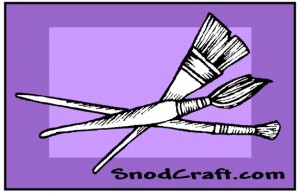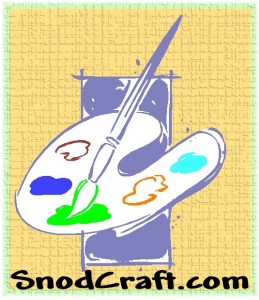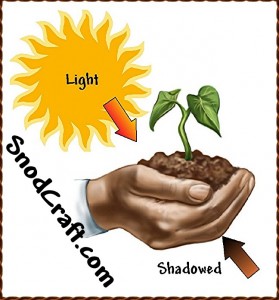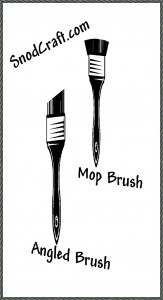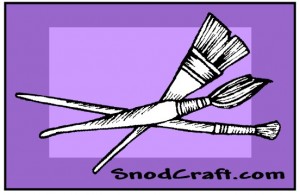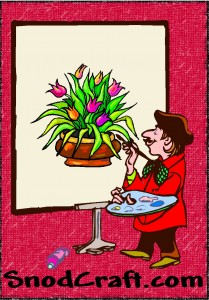 Ever wonder how the artist draws the design or scene onto a wooden shape, canvas, fabric or watercolor picture? Little artistic talent is needed to reproduce a patterned design onto your favorite painting medium and SnodCraft would like to offer a few helpful hints to disperse any artistic fears you may have.
Ever wonder how the artist draws the design or scene onto a wooden shape, canvas, fabric or watercolor picture? Little artistic talent is needed to reproduce a patterned design onto your favorite painting medium and SnodCraft would like to offer a few helpful hints to disperse any artistic fears you may have.
Begin your artistic venture by searching for pattern books. There are dozens of artists who have published their own individual style in books or pattern packets. There’s a wide range of subject matter available and you are sure to find something that interests you. Start in your local craft store for pattern books, or without leaving your armchair, browse through the SnodCraft internet links: Di Hiller Productions or Artist’s Club. Another source on-line is Vikings Woodcrafts (Vikingwoodcrafts.com). Whether you are looking for whimsical designs, picturesque landscapes, flowers, animals, gardens or whatever the subject, there’s plenty from which to choose. When browsing through pattern books try to “think outside the box”. Perhaps part of a landscape pattern really catches your eye, or perhaps you’d prefer the moose all by himself instead of next to a bear, or you love a design found in an acrylic or oil pattern book, but would rather paint it in watercolor, or on glass. Let your imagination take over! Keep in mind should you find a Di Hiller design on her site, you can order our Paint-It-Yourself wood kit to match the pattern you have selected.
How does the pattern get transferred to your art project? The key word is “transferred”. You’ll need “transfer paper” and “tracing paper”, which are both available through the links mentioned above, or at your local craft store. By the way, NEVER use regular carbon paper to transfer a design! Carbon paper will bleed through paints, smears, and will ruin your painting! Transfer paper on the other hand contains no wax or grease, erases like pencil, won’t smear, washes out of fabric, and can be used again and again. It comes in several colors – black, white, and blue. White and blue transfer papers are recommended for tracing onto dark surfaces; black is recommended for most light papers, canvas, or wood surfaces.
Let’s get started –
Step 1: Lay the tracing paper over the pattern or just the part of the pattern you wish to use and carefully trace the design onto the tracing paper using a No.5 lead mechanical pencil. Trace as much detail as you feel you’ll want in the finished project. Tracing paper can tear easily so be careful and don’t apply too much pressure with your pencil.
Step 2: Place the tracing atop the wood, canvas, watercolor, or fabric. It is imperative your tracing is placed exactly where you want the finished painting, so take your time and place it with care! Once you have it placed, lightly tape it down with a small piece of blue painter’s tape. Now gently slide an appropriate sized piece of transfer paper under your tracing and begin following the trace lines. If you are transferring onto a shaped wood piece you can often omit some of the trace lines, apply some base coats and then trace the remaining details after the paint dries. However, if you are tracing a landscaped scene, add all your trace lines since it will be difficult to line it up to the same position a second time. Recommended tool for transferring the traced lines is a thin pointed stylus tool (available at your local craft store). Again, be careful following the lines so you don’t tear the tracing paper or dent the wood with your trace lines.
Step 3: Once you have transferred the pattern, remove the transfer and tracing papers. Your project is now ready for paint.
Here’s an idea – There are several fun-to-use paint mediums available: if painting on fabric look for special fabric paints or use the standard acrylic paints but add a “textile medium” which makes your project more durable and washable. If painting with watercolor try the “masking medium” which when applied leaves those places white while you add color all around them. You later remove the masking medium with an eraser when all is complete. If painting with acrylic paints try using Deco Art’s “Canvas Gel”. It allows you to blend and paint as if you were using oil paints. Or, if painting with oil try adding a small amount of sand to your paint. This adds texture and depth. You’ll feel like an artist with each creative attempt.
If you would like a particular painting question answered,use our Contact link on the Home page. We’d love to hear from you!
Happy Painting!
